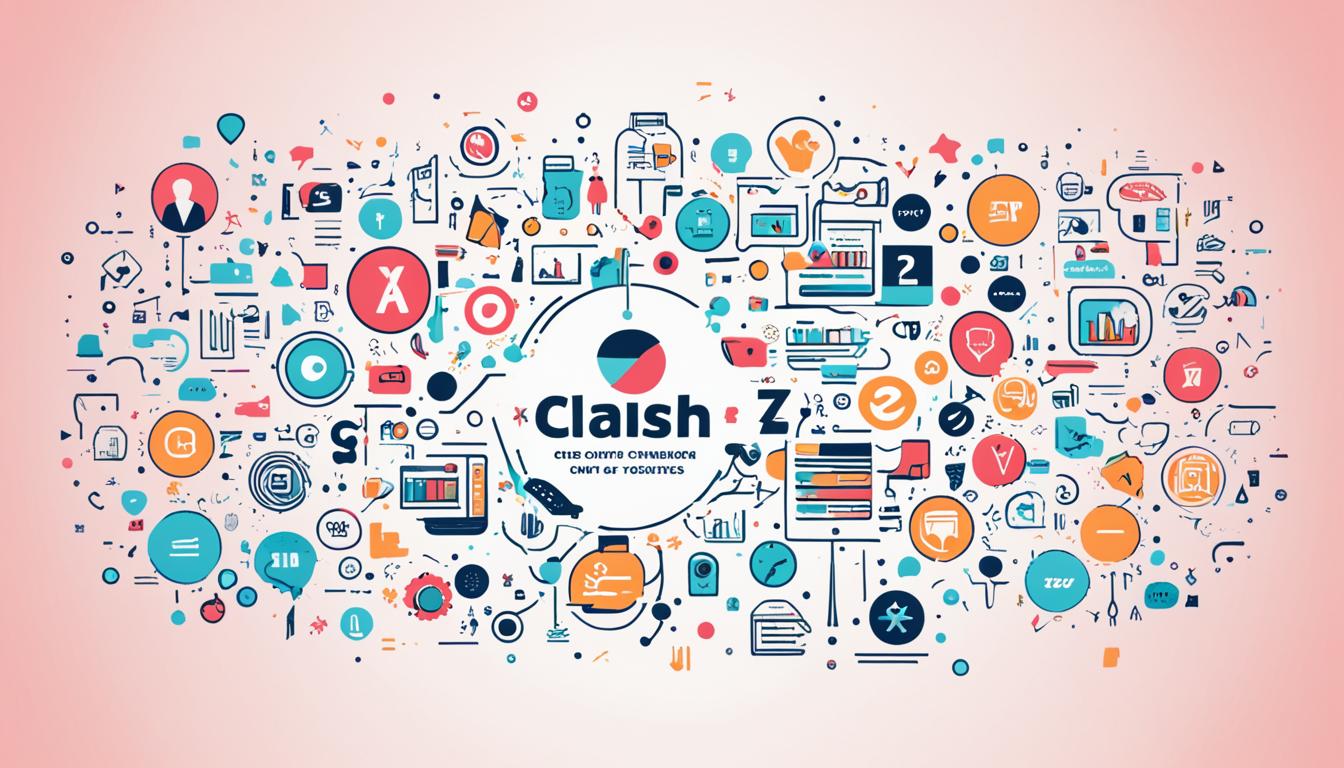Psychographic segmentation is a powerful market research method that allows businesses to understand their target audience on a deeper level. By analyzing the beliefs, values, lifestyle, social status, activities, interests, opinions, and other psychological criteria, businesses gain insights into consumer behavior and motivations. This understanding enables them to tailor their branding, marketing strategy, and product development to resonate more effectively with specific segments.
Unlike behavioral and demographic segmentations, psychographic segmentations tend to have a longer shelf life. By combining psychographic insights with other forms of data such as demographic, transactional, and behavioral data, businesses can enhance their understanding of the target audience, leading to more accurate customer profiling and more informed marketing strategies.
Key Takeaways:
- Psychographic segmentation divides a market or customer group based on their beliefs, values, lifestyle, and other psychological criteria.
- It provides businesses with a deeper understanding of their target audience’s motivations and enables them to tailor their branding, marketing strategy, and product development.
- Combining psychographic insights with demographic, transactional, and behavioral data enhances the depth and accuracy of understanding a target audience.
- Psychographic segmentation helps in creating personalized marketing campaigns, customer profiling, and analyzing buying habits.
- Businesses can use psychographic segmentation techniques to gain a competitive edge and drive success in their marketing efforts.
Benefits of Psychographic Segmentation
Psychographic segmentation offers several benefits to businesses. By diving deeper into the intrinsic motivations, desires, and lifestyles of their target market, businesses gain valuable customer insights. This deeper understanding allows businesses to tailor their communication and offerings to resonate more powerfully with their target audience.
One of the key advantages of psychographic segmentation is the ability to implement personalized marketing. By identifying the psychographic attributes of different segments, businesses can create targeted marketing campaigns that speak directly to the unique needs and preferences of each segment. This personalized approach enhances customer engagement and drives better results.
Furthermore, psychographic segmentation enables customer-centric product development. Businesses can use the insights gained from psychographic segmentation to shape products and services that seamlessly integrate into a customer’s life and address their specific pain points. This customer-centric approach enhances the overall customer experience and fosters enhanced loyalty and retention.
Another advantage of psychographic segmentation is efficient resource allocation. By understanding the psychographics of their target audience, businesses can allocate their marketing resources more effectively. They can create targeted marketing campaigns that resonate with specific segments, resulting in less wastage of marketing dollars and improved ROI.
In summary, psychographic segmentation offers businesses a comprehensive understanding of their target audience, leading to customer insights, personalized marketing, customer-centric product development, enhanced loyalty and retention, and efficient resource allocation.
| Benefits of Psychographic Segmentation: |
|---|
| Customer Insights |
| Personalized Marketing |
| Customer-Centric Product Development |
| Enhanced Loyalty and Retention |
| Efficient Resource Allocation |
Using Psychographic Segmentation with Other Data
Psychographic segmentation is a powerful market research method that offers businesses a deeper understanding of their target audience’s motivations and psychological criteria. However, it is most effective when combined with other forms of data, such as demographic, transactional, and behavioral data.
Demographic data provides basic information about the target audience, including age, gender, income, and education. This data helps businesses frame who their audience is and understand their characteristics.
Transactional data, on the other hand, provides insights into customers’ purchase history and preferences. By analyzing this data, businesses can gain a better understanding of their target audience’s preferences and priorities.
Behavioral data showcases the customer journey, from initial interest to post-purchase interactions. It reveals why certain touchpoints matter more to specific segments and helps businesses understand their audience’s behaviors and motivations.
By combining psychographic insights with demographic, transactional, and behavioral data, businesses can gain a more comprehensive understanding of their target audience. This combination of data allows for more targeted and personalized marketing strategies, as businesses can tailor their campaigns to resonate with specific segments based on their psychographic profiles.
Through the integration of psychographic segmentation and other forms of data, businesses can create marketing campaigns that are more targeted and effective in reaching their desired audience. This approach enhances the depth and accuracy of understanding and enables businesses to deliver relevant messages and experiences to their customers.
Building Psychographic Segments
Building psychographic segments involves a step-by-step guide that ensures accurate and targeted audience segmentation. By following these steps, businesses can gain valuable insights into their target audience and create more personalized marketing campaigns.
Step 1: Defining the Objective of Segmentation
The first step in building psychographic segments is defining the objective of the segmentation. Businesses need to determine the specific purpose of the segmentation, whether it’s tailoring a product, refining an ad campaign, or understanding consumer behavior in a particular category.
Step 2: Research Tools and Data Collection
Research tools and data collection methods play a vital role in capturing psychographic attributes related to the category of interest. Surveys, questionnaires, and interviews are effective tools for collecting data from the target audience. These tools help in gathering valuable information about their beliefs, values, interests, and lifestyle.
Step 3: Data Analysis for Pattern Identification
Once the psychographic data is collected, the next step is to analyze the data to identify patterns and underlying psychographic similarities. Through data analysis techniques, businesses can uncover key insights and segment their audience based on shared characteristics.
Step 4: Segment Naming and Profiling
After identifying the psychographic segments, it’s essential to give them descriptive names and create detailed profiles outlining their key psychographic traits. This step helps in visualizing and understanding each segment’s unique characteristics, allowing businesses to tailor their marketing strategies accordingly.
Step 5: Segment Validation through Data Cross-Referencing
To validate the relevance of the psychographic segments, businesses can cross-reference the data with existing customer data or conduct mini-campaigns targeting specific segments. This step ensures the accuracy and effectiveness of the segment profiles and their alignment with the target audience.
Step 6: Iteration for Continued Relevance
Building psychographic segments is an iterative process that requires continuous assessment and updates. It is essential to reassess and update the segments regularly to ensure their continued relevance in response to market dynamics and evolving consumer attitudes.
By following this step-by-step guide, businesses can effectively build psychographic segments that provide deep insights into their target audience. These segments enable businesses to create more targeted and personalized marketing campaigns, enhancing engagement, and driving success in their marketing efforts.
Examples of Companies Using Psychographic Segmentation
Psychographic segmentation is a powerful tool that many successful brands utilize to better understand their target audience and create effective marketing campaigns. By diving deeper into the beliefs, values, and lifestyles of their consumers, these companies can tailor their messaging and offerings to resonate more effectively with specific segments. Here are some examples of companies that have successfully implemented psychographic segmentation:
1. Patagonia: Patagonia, known for its commitment to environmental consciousness, uses psychographic insights to tailor its branding and campaigns to resonate with environmentally conscious outdoor enthusiasts. By understanding the values and lifestyle preferences of their target audience, Patagonia has cultivated a loyal customer base that shares their commitment to sustainability and the outdoors.
2. Snapchat: Snapchat leverages psychographic segmentation to gain insights into its audience’s preferences and behaviors. This understanding allows them to personalize the app features and advertising that appear on the platform. By catering to the unique interests and preferences of their users, Snapchat creates a more engaging and personalized experience.
3. Coca-Cola: Coca-Cola, a global beverage giant, targets different psychographic segments with its marketing campaigns. By understanding the psychographic profiles of their audience, Coca-Cola creates tailored campaigns that emotionally connect with consumers. Their marketing appeals to specific segments based on their values, beliefs, and lifestyle preferences, enabling them to build a strong emotional connection with their customers.
4. Nike: Nike utilizes psychographic segmentation to understand the desires and motivations of its target audience. By analyzing the psychographics of athletes and sports enthusiasts, Nike creates products and marketing campaigns that inspire and empower individuals to reach their full athletic potential. By tapping into their customers’ values and passions, Nike establishes a strong emotional bond that goes beyond functional benefits.
These examples demonstrate the power of psychographic segmentation in building successful marketing strategies. By understanding their target audience’s beliefs, values, and lifestyle preferences, these companies can create tailored campaigns that resonate on a deeper level with their consumers, fostering brand loyalty and driving business success.
| Company | Segmentation Strategy |
|---|---|
| Patagonia | Environmental consciousness |
| Snapchat | Personalized app features and advertising |
| Coca-Cola | Tailored campaigns and emotional connection |
| Nike | Inspiring and empowering athletes |
The Importance of Psychographics in Marketing
Psychographics play a crucial role in marketing as they provide valuable insights into consumer motivations and attitudes. While demographic data offers basic information about the target audience, psychographic data dives deeper and reveals the underlying reasons behind consumers’ purchasing decisions. By understanding the psychological attributes of their audience, marketers can create relevant marketing content that resonates with their target customers, driving engagement and conversions.
Psychographics help marketers gain a deeper understanding of consumer behavior and develop accurate buyer personas, which are detailed representations of ideal customers. Buyer personas enable marketers to create targeted marketing campaigns that appeal to specific segments based on their motivations, preferences, and values. By crafting messaging and content that aligns with the psychographic profiles of their audience, marketers can establish a strong emotional connection and increase the effectiveness of their campaigns.
By utilizing psychographic insights, businesses can create personalized marketing campaigns that address the unique needs and desires of their target audience. This approach allows marketers to tailor their messaging, offers, and creative content to specific segments, enhancing the relevance and appeal of their marketing efforts. Targeted marketing campaigns based on psychographics lead to higher engagement, improved customer satisfaction, and ultimately, increased conversions and sales.
Understanding Consumer Behavior with Psychographics
Psychographics provide valuable insights into consumer behavior by uncovering the underlying beliefs, values, and interests that influence their purchasing decisions. Unlike demographic data, which only provides a surface-level understanding of the target audience, psychographic data delves into the mindset and motivations of consumers.
By analyzing psychographic data, marketers can gain a deeper understanding of their target audience’s preferences, desires, and pain points. This understanding enables them to create relevant marketing content that addresses the specific needs and aspirations of their customers. By aligning their messaging and offerings with consumer psychographics, marketers can establish a strong connection with their audience and build long-term relationships.
Developing Buyer Personas for Targeted Marketing
Psychographics play a vital role in developing accurate buyer personas, which are detailed representations of the ideal customers that businesses want to target. Buyer personas go beyond demographic information and uncover the psychological traits, interests, and values that define different customer segments.
By understanding the psychographic profiles of their target audience, businesses can create marketing strategies that resonate with specific segments. This targeted approach allows marketers to craft messaging and offers that address the unique motivations and preferences of each segment, increasing the effectiveness of their marketing efforts.
Creating Relevant Marketing Content with Psychographics
| Benefits of Using Psychographics in Marketing |
|---|
| 1. Enhanced understanding of consumer motivations and attitudes |
| 2. Ability to create personalized marketing content |
| 3. Establishing an emotional connection with the target audience |
| 4. Increased relevance and engagement |
| 5. Improved customer satisfaction and loyalty |
Pyschographics play a critical role in creating relevant marketing content that resonates with the target audience. By understanding their audience’s motivations, preferences, and values, marketers can develop messaging and content that reflects their customers’ unique perspectives. This approach ensures that the marketing content is relevant, engaging, and speaks directly to the needs and desires of the target audience.
Psychographics enable marketers to establish an emotional connection with their audience by crafting content that aligns with their values and aspirations. By understanding the psychological attributes of their customers, marketers can elicit powerful emotions that drive engagement and foster loyalty.
With psychographic insights, marketers can create targeted marketing campaigns that appeal to specific segments based on their motivations, preferences, and values. This targeted approach ensures that the right message reaches the right audience, increasing the relevance and effectiveness of marketing efforts.
Psychographics vs. Demographics
Psychographics and demographics are two important aspects of understanding consumer behavior and making effective marketing decisions. While demographics focus on objective data such as age, gender, income, and marital status, providing a basic understanding of who the buyer is, psychographics go deeper into the psychological and cognitive attributes of the consumer.
Psychographics encompass personality characteristics, lifestyle choices, social class, habits, behaviors, and interests. These factors reveal the motivations and reasons behind consumers’ purchase decisions, allowing marketers to create more targeted and tailored marketing campaigns that resonate with specific segments.
Demographics provide a broad overview of the target audience, giving marketers surface-level insights into their customers. On the other hand, psychographics provide a deeper understanding of consumer behavior by exploring the psychological facets that influence purchase decisions.
By combining demographics and psychographics, marketers gain a comprehensive understanding of their target audience. This holistic approach allows for more accurate and personalized marketing campaigns that connect with consumers on a deeper level.
Psychographics provide insights into the underlying motivations and desires that drive consumer behavior, enabling marketers to create messaging and campaigns that resonate with specific segments. By understanding the personality characteristics, lifestyle choices, social class, habits, behaviors, and interests of their target audience, marketers can craft compelling marketing messages that appeal to their customers’ values and aspirations.
The table below illustrates the differences between psychographics and demographics:
| Psychographics | Demographics |
|---|---|
| Focus on psychological and cognitive attributes | Focus on objective data |
| Reveal motivations and reasons behind purchase decisions | Provide surface-level insights |
| Explore personality characteristics, lifestyle, social class, habits, behaviors, and interests | Consider age, gender, income, and marital status |
| Delve deeper into consumer behavior | Provide a general overview of the target audience |
Understanding both psychographics and demographics is crucial to developing a well-rounded marketing strategy. While demographics provide basic information about the target audience, psychographics uncover the underlying motivations and preferences that drive consumer behavior. By combining these two approaches, marketers can create targeted and tailored marketing campaigns that resonate with specific segments and lead to increased customer engagement and conversions.
Psychographic Profiling and Factors
Psychographic profiling is a valuable technique in market research that involves creating detailed descriptions of individuals or groups based on their attitudes, habits, and interests. By considering various factors such as personality characteristics, lifestyle, social class, habits, behaviors, and interests, businesses can gain deeper insights into their target audience and effectively segment their market.
Personality characteristics play a significant role in how individuals interact with the world around them. It influences their preferences, decision-making process, and overall behavior. Understanding personality traits helps businesses tailor their marketing strategies to resonate with different personality types and create personalized experiences.
Lifestyle is another important factor to consider when profiling individuals. It reflects how a person views themselves within society and encompasses their values, interests, activities, and daily routines. By understanding an individual’s lifestyle, businesses can align their products and marketing messages to match their target audience’s preferences and aspirations.
Social class provides insights into the types of people who use certain products and their preferences. It helps businesses understand the purchasing power, cultural norms, and lifestyle choices of different socioeconomic groups. By recognizing the influence of social class, companies can effectively target specific segments with tailored marketing campaigns that resonate with their unique needs and aspirations.
Habits and behaviors reveal patterns in individuals’ daily lives and their decision-making processes. This data helps businesses uncover valuable insights about their target audience, such as their shopping habits, media consumption, and brand loyalty. By understanding these habits and behaviors, marketers can align their strategies to target specific segments effectively.
Interests play a crucial role in how individuals interact with a brand or product. By understanding the interests of their target audience, businesses can create relevant and engaging marketing content that captures attention and forms a connection. Interests can range from hobbies and activities to social causes or personal development, and recognizing which interests align with their target audience helps companies create more impactful campaigns.
A well-executed psychographic profiling, including analyzing personality characteristics, lifestyle, social class, habits, behaviors, and interests, enables businesses to segment their audience and create more targeted marketing campaigns. By understanding the unique psychographic traits of their audience, businesses can develop strategies that resonate on a deeper level, forging strong connections and driving success in their marketing efforts.
| Factors | Description |
|---|---|
| Personality Characteristics | The unique traits and qualities that shape an individual’s behavior and decision-making processes. |
| Lifestyle | The values, interests, activities, and routines that define an individual’s way of life. |
| Social Class | The socioeconomic group an individual belongs to, influencing their purchasing power and lifestyle choices. |
| Habits and Behaviors | Patterns in an individual’s daily life, including their shopping habits, brand loyalty, and media consumption. |
| Interests | The hobbies, activities, and causes that capture an individual’s attention and shape their interactions with brands. |
Psychographic Data and Finding Data
Psychographic data plays a crucial role in understanding consumers and their purchasing behaviors. It includes valuable insights into various aspects of the buyer’s life, such as their spending habits, hobbies, thoughts, and values. This data provides marketers with a deeper understanding of the motivations and desires behind consumer decisions, allowing them to create targeted and personalized marketing campaigns that resonate with specific customer segments.
There are several effective methods for collecting psychographic data:
- Interviews: By conducting interviews with existing clients or target audience members, marketers can gain firsthand knowledge of their interests, habits, and goals. These interviews provide valuable insights into consumer preferences and can help shape marketing strategies.
- Website Analytics: Investigating website analytics allows marketers to gather data on customer behavior and preferences. By analyzing metrics such as page views, click-through rates, and conversion rates, marketers can understand how customers engage with their brand online and tailor their marketing efforts accordingly.
- Focus Groups: Focus groups provide an opportunity to gather unbiased opinions and feedback about a brand and its products. By bringing together a group of individuals who represent the target audience, marketers can gain valuable insights into their thoughts, perceptions, and preferences.
By utilizing these data collection methods, marketers can gather comprehensive psychographic data that enables them to create more targeted and effective marketing campaigns. Understanding customers’ spending habits, hobbies, thoughts, and values allows marketers to develop a customer-centric approach and build meaningful connections with their audience.
Importance of Combining Psychographic Segmentation with Demographic Data
While psychographic segmentation provides valuable insights into consumer motivations and behaviors, combining it with demographic data enhances the understanding of the target audience. Demographic data provides basic information about the audience’s age, gender, income, and other factors that help in creating a comprehensive understanding of the target market. By combining psychographic and demographic data, businesses can create targeted marketing campaigns that resonate with specific segments of their audience. This combination allows for more accurate audience targeting and personalized campaigns that increase engagement and conversions.
Comprehensive Understanding of the Target Market
Psychographic data reveals the psychological attributes and motivations of the audience, while demographic data provides a broader overview of their characteristics. By merging these two types of data, businesses can gain a comprehensive understanding of their target market. They can identify the psychographic traits that are more prevalent within specific demographic groups, uncovering valuable insights into consumer behavior and preferences.
Targeted Marketing and Personalized Campaigns
Combining psychographic and demographic data enables targeted marketing and personalized campaigns. Businesses can use the insights gained from psychographic segmentation to identify the specific psychographic profiles within their target audience. By combining this information with demographic data, they can tailor their marketing messages, product offerings, and advertising strategies to resonate with these specific segments. This level of personalization helps businesses connect with their audience on a deeper level, increasing engagement and driving conversions.
Accurate Audience Targeting
By combining psychographic and demographic data, businesses can ensure more accurate audience targeting. They can identify the psychographic traits and preferences that are more prevalent within certain demographic groups, allowing them to create campaigns that are highly relevant and appealing to those segments. This precision targeting helps businesses optimize their marketing efforts, resulting in higher conversion rates and return on investment.
In summary, combining psychographic segmentation with demographic data is essential for gaining a comprehensive understanding of the target audience. It allows businesses to create targeted marketing campaigns, personalized offerings, and accurate audience targeting. By harnessing the power of both psychographic and demographic data, businesses can optimize their marketing strategies and drive success in their campaigns.
Using Psychographics to Create Relevant Marketing Content
Psychographics play a vital role in creating relevant marketing content that appeals to the target audience. By understanding the psychological attributes of the audience, marketers can appeal to their motivations, desires, and values. This deep understanding allows for the development of content that forms an emotional connection with the audience, increasing engagement and driving conversions.
A customer-centric approach is key in using psychographics to create marketing content. Marketers can personalize the content to specific segments based on their psychographic profiles, tailoring it to resonate with their unique preferences and interests. This personalization ensures that the marketing content speaks directly to the audience and creates a sense of relevance and connection.
When crafting marketing content, marketers should focus on appealing to the target audience in a way that aligns with their psychographic traits. By understanding their values, interests, and beliefs, marketers can create content that addresses their specific needs, desires, and pain points. This approach not only enhances the effectiveness of the marketing campaign but also cultivates a stronger relationship between the brand and its target audience.
Furthermore, a customer-centric approach based on psychographics helps marketers understand the unique characteristics of their audience segments. By tailoring the marketing content to different psychographic profiles, marketers can create content that speaks to the individuality of each segment, ensuring a more engaging and relevant experience for the audience.
Benefits of Using Psychographics in Marketing Content:
- Creates an emotional connection with the audience
- Enhances relevance and personalization
- Appeals directly to the motivations, desires, and values of the audience
- Improves engagement and drives conversions
| Psychographic Trait | Benefit |
|---|---|
| Interests and Hobbies | Allows for content that aligns with the audience’s passions |
| Values and Beliefs | Enables the creation of content that resonates with the audience’s core principles |
| Lifestyles and Preferences | Guides the development of content tailored to the audience’s specific lifestyle and preferences |
| Attitudes and Opinions | Informs the creation of content that reflects the audience’s perspectives and concerns |
Psychographics provide valuable insights that can guide marketers in creating relevant marketing content that resonates with their target audience. By harnessing the power of psychographic segmentation, marketers can connect with their audience on a deeper level and drive the success of their marketing efforts.
Conclusion
Psychographic segmentation is a powerful market research method that enables businesses to gain a deeper understanding of their target audience. By identifying the beliefs, values, lifestyle, and other psychological criteria that influence consumer behavior, businesses can customize their marketing strategies, product development, and communication to connect more effectively with specific segments. Combining psychographic data with demographic, transactional, and behavioral data provides a comprehensive understanding of the target audience and allows businesses to create personalized and targeted marketing campaigns.
With the insights gained from psychographic segmentation, businesses can build stronger connections with their audience and drive success in their marketing efforts. By resonating with the psychological attributes that motivate their target audience, businesses can create compelling marketing content that addresses their customers’ needs and desires. This deeper level of understanding allows businesses to create a more customer-centric approach, resulting in enhanced engagement, loyalty, and brand advocacy.
Ultimately, psychographic segmentation empowers businesses to move beyond surface-level demographics and tap into the emotional drivers behind consumer behavior. By leveraging the power of psychographic insights, businesses can create meaningful connections with their target audience and drive long-term success in today’s dynamic and competitive marketplace.







